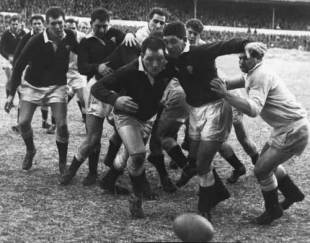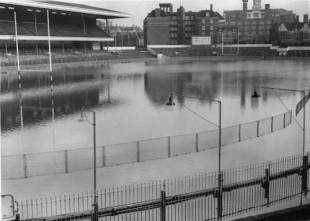|
1960
Elements leave their mark in Cardiff
Huw Richards
February 13, 2009

Wales' Norman Gale holds off England's John Thorne as Denzil Williams goes for the ball during their clash at the Arms Park in 1963
© Getty Images
Enlarge
It is no coincidence that of all the Six Nations venues, Cardiff has gone furthest to protect itself from the weather. Firmly implanted in Welsh folk-memory are the numerous occasions when conditions at the old Arms Park ground - on the same land as the Millennium Stadium, but at a different angle - were all but impossible. It suffered several problems. It was on land reclaimed from the River Taff, which made regular attempts to revise the settlement. It was hideously over-used. As that proud Cardiffian Bleddyn Williams will tell you 'Wales played on it, Cardiff played on it, and the 'Rags'. There must have been 70 games a year, so it never got a chance to recover'. And the international season of the time was little earlier than now, with England v Wales usually played in mid January, so the chance of bad weather was that much greater. The usual image of Cardiff before the late 1960s, when Cardiff moved next door and drainage issues were addressed as part of the transformation of the Arms Park into the National Stadium, is as a sea of sodden mud, leading one Irish player to bemoan in 1921 'the lack of foresight of the Welsh Union in not providing lifebelts'. The 1970 match against South Africa, concluded by Gareth Edwards desperate dive to the corner for an equalising try that had little chance of being converted - it was an achievement to lift the ball out of the mud, never mind direct it accurately between the posts from the touchline - was among the last played in such conditions. No Cardiff match, because of its timing, suffered more than England v Wales. So many were played by men turned into encrusted troglodytes - the journalist John Morgan wrote that a well-travelled spectator in 1959 was reminded of 'wrestling in the mud at a Hamburg night-club' - that it is easier to recall those played in decent conditions. Two of the most memorable, though, were afflicted by a phenomenon of which we have all been reminded over the last couple of weeks - freezing temperatures, snow and ice. England's first ever visit to Cardiff in 1893 - earlier matches in Wales had been played at Swansea, Newport and Llanelli - was played in the midst of a ferocious freeze and only saved by a Cardiff committeeman who bought hundreds of large buckets, had holes drilled in the bottom, filled them with coal and lit fires. This ingenious unfreezing mechanism left black marks on the pitch and the sight of hundreds of them flaming away on the night before the match put one English journalist in mind of Dante's Inferno, but made one of the fixture's genuine epics possible. Wales trailed by nine points - a huge margin at the time - but struck back to win 12-11 thanks to the remarkable wide-angled drop goal by Billy Bancroft that launched them towards their first ever Triple Crown. England half-back Howard Marshall scored a hat-trick in his only international, but finished on the losing side.

Torrential rains saw the Arms Park flooded in December 1960
© Getty Images
Enlarge
Still in living memory is the scarcely less remarkable match of 1963, played amid a winter that the Met Office reckoned the coldest since the 1740s with huge piles of straw close to the touchlines and a collection of agricultural equipment, including three tractors, behind the goal at the Taff End. It was too cold to train outside and Wales's new half-backs David Watkins and Clive Rowlands, forbidden to use a ball in the gym at Newport, had to practice with a rolled-up tracksuit. Rowlands, captain in his first match for Wales, still remembers both his disappointment that the players were kept indoors during the anthems and the clicking noise of studs on hard-frozen ground as they ran on to the pitch. It was, another Wales debutant, Roger Michaelson, has recalled 'so cold that even Clive Rowlands stopped talking' - not something that has happen very often in his years since as player, national coach, WRU official and broadcaster. The match was as chaotic as you might expect, with frozen hands dropping passes and players skidding haplessly past the ball as they attempted to pick up. Amid it all was one truly great moment - England's first-half try. Wing Jim Roberts threw a long line-out on his own 25, centre Mike Weston gathered and passed on to partner Malcolm Phillips. He scissored with wing Peter Jackson, who passed rapidly back near halfway. Phillips, given a small overlap, made it all the way to the line in the face of an icy wind. It would have been some score in good conditions. On an icefield it was little short of miraculous and the key moment in the 13-6 victory by an England team featuring seven new caps, including the entire front five. This match was to have a particularly long run in popular memory, as England's last victory at Cardiff for 28 years. Particularly in the later stages of that run, its story was recounted in newspaper features and match programmes every two years before England tried again. Rowlands is too proud a Welshman to have welcomed England's eventual victory in 1991, but admits he was glad no longer to have to relive the defeat every two years. Typically, though, even then he managed to have the last word. As he recalls :"I always pointed out that I'd also begun the winning run in 1965". Huw Richards' latest book - The Red & the White: The Story of England v Wales Rugby - is out now, published by Aurum. © Scrum.com
|
Live Sports
Communication error please reload the page.
-
Football
-
Cricket
-
Rugby
-
- Days
- Hrs
- Mins
- Secs
F1 - Abu Dhabi GP
Abu Dhabi Grand Prix December 11-131. Max Verstappen ()
2. Valtteri Bottas (Mercedes)
3. Lewis Hamilton (Mercedes)
4. Alexander Albon ()
5. Lando Norris ()
6. Carlos Sainz Jr ()
-
ESPNOtherLive >>
Golf - Houston Open
Snooker - China Open
Tennis - Miami Open

